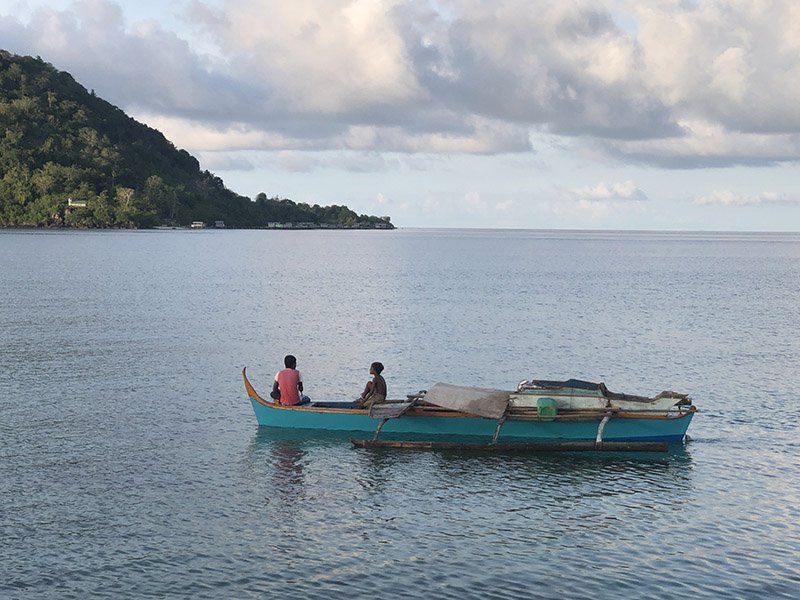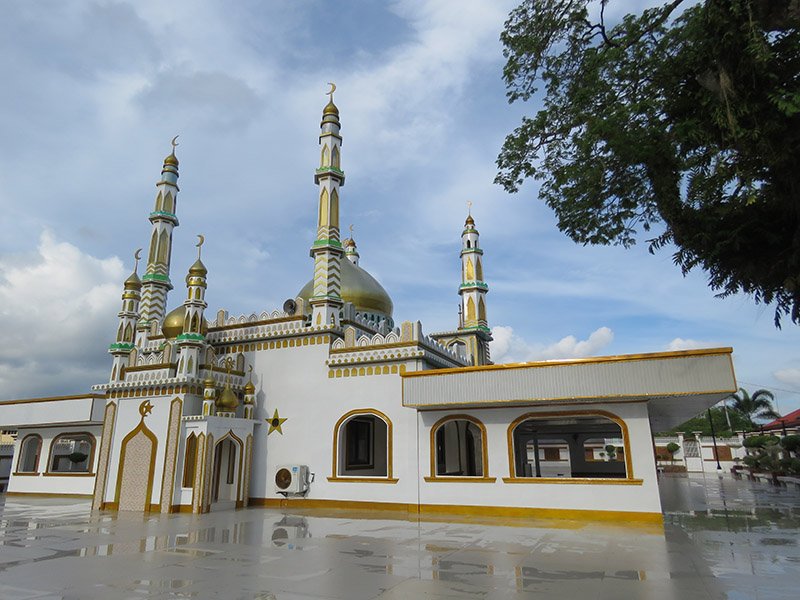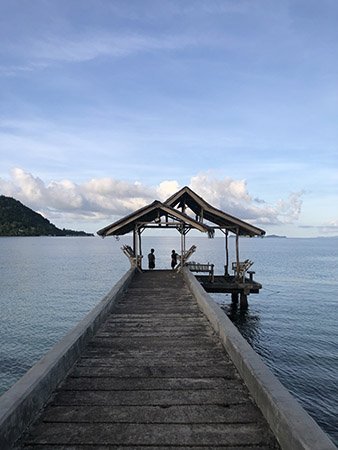Sulu, Yesterday and Today

Fishermen (Photo by Criselda Yabes)
For about 15 years I went to this island, Sulu, at the very south of the country, at least once a year until right before the pandemic struck in early 2020. I had been covering the “conflict management” policy followed by some military officers to find an end to the Muslim insurgency.
For 15 years there was a lot of push and pull, some progress and then some unexpected backlash. There were seasons of killings, kidnappings, bombings. Sometimes I’d think it was getting much better, only to see the situation fall behind the target for peace. Sulu had gone to the abyss after a failed uprising in 1974, ruining the paradise it once was.
I was back in April this year, about five years since my last trip. I was told it was “different” now and I had to see it. Upon landing at the airport – something that you might see in the outback but so close to the center – I knew what was familiar. I knew my friend would be waiting for me at the Dennis café down the road where we had our breakfast of Sulu coffee and fried bananas.
From there, a junior military officer picked me up for a ride up to Bud Datu, a hill on the outskirts, where I would be staying. I knew this place by heart. If I were to have a measure of the island, I’d see it from the camp of Bud Datu that I have known from the beginning of my love affair with Sulu. Immediately, I was assailed by memories and an overwhelming sensation of forgetting the past, to be greeted by a fresh whiff of freedom.

View of Jolo from an army camp on Bud Datu, known as the Hill of Rulers (Photo by Crisela Yabes)
The military camp on Bud Datu used to be a dilapidated whitewashed house on the verge of falling over the cliff. I had slept on cots and had been terrified of going to the bathroom. Today, it’s a concrete structure. The mess hall is on the balcony, better than it used to be, banishing the fear that the scaffold would break. There’s a bar. The television is tuned to a music travel video. My room across is a refurbished container van with my own bathroom.
As was the usual case, I was given a minder. Her name was Anna May, a young Muslim lady who is an army corporal in fatigue uniform and a hijab. She was going to take me around on her motorbike, but the commander wouldn’t hear of it and instead offered one of the SUVs – not the jalopies they used to have – at my disposal.
For a full week of my stay on Bud Datu, Anna May and I were a team. We went to the new public library in town, to the new replica of the Astana that was the palace of the last sultanate. We went everywhere, to places I knew and others that I was seeing for the first time, places that I had been forbidden to go because you never knew if the rebels were lurking around.

The newly built modern public library in the center of Jolo. (Photo by Crisela Yabes)
The public library next door to the city hall is very modern: it has an elevator, an audiovisual room with plush, red cushioned seats, a rooftop from where I could see the goings-on below in the maze of a rundown town, and the mesmerizing slope of the crying mountain – Bud Tumatangis – in the background. But there’s not enough books on the shelves and only a few students were using the desktop computers.

Bud Tumatangis, the crying mountain, looking down on the small town of Jolo, the cathedral on one side, the mosque on the other -- symbol of what was once a solid community before the 1974 Muslim uprising. (Photo by Crisela Yabes)
The Astana that the governor had built is a stunning recreation located by the last sultan’s grave in the town of Maimbung, on the opposite coast of the capital, Jolo. The rain that usually arrived in the afternoons lent a nostalgic feel during our private visit. We had the palace all to ourselves. I don’t know why it had taken long for the governor to recreate this part of Sulu’s history. His own mansion is not far away, his son’s modern house across the street. Their private mosque, replacing the sultan’s ochre mosque by the wharf, is just as extravagant compared with the poor houses of the people living down the road. Over the years, Sulu has become one of the most impoverished provinces.

A replica of the last sultan's palace in the coastal town of Maimbung, opposite site from Sulu's capital of Jolo. (Photo by Crisela Yabes)

The governor's extravagant mosque in his Maimbung bailiwick. (Photo by Crisela Yabes)
In the past, getting here meant organizing a convoy of military vehicles. Today it’s a breeze, a quick drive to any place I chose to go. It used to be that I couldn’t leave the camp whenever I pleased. Perhaps the freedom I felt now is the same as watching the people swim and picnic by the waterfall of Maimbung – such a sight! It’s as if they have found playground and are reveling in the sun and water.

Happy days for villagers at a park of waterfalls. (Photo by Crisela Yabes)
With Anna May, I went shopping in town, which has more side street cafes and canteens. Shopping meant bazaars and flea markets, nothing fancy. When at last I found a linen blouse suitable enough for a conference, it was in a “boutique” that’s more than a hole in the wall. When I needed tee-shirts and walking outfits, I was taken to Simply Joy, an air-conditioned shop that sold clothing from Manila. The name certainly brought joy to my seemingly daunting excursion and I got a free bookmark with my purchases.
Long ago, I was scolded for walking into the public market alone, when I was just looking for fresh fruit to eat. It had been drilled into my head that I must never go anywhere by myself, and though I sometimes defied it, staying in a military camp meant I had to follow rules. It’s true that in the 1990s I had my freedom to drive around in a friend’s beat-up Land Rover, before the Abu Sayyaf rebel group came into being and terrorized the island. Their lair was in the town of Patikul, so near the capital that it practically surrounded it. No one talks about them anymore, as if the nightmare is over.
If there was any clear sign that life is better, all I had to do was to look at our next-mountain neighbor from Bud Datu. Right beside Bud Datu is Bud Agad. There on its hilltop is a world of unimaginable luxury for the ordinary folks of Sulu: a resort with a swimming pool, jacuzzi in bedroom suites, a café that overlooks the town below. An ostrich and a peacock walked around the garden, objects of wonder for the guests. I would be invited here as guest for a conference, but at the end of the day it’s Bud Datu that lured me back. I’m a sucker for nostalgia.
What changed in Sulu?
For one thing, the pandemic played a hand: it stopped the fighting. Who could the rebels kidnap when there was no one in sight? Who could they kill when the Covid virus itself was mortally risky? And for the military, it was right timing to install a division in 2018, a massive upgrade from the usual brigade-size presence. The Army’s 11th Infantry Division oversees the entire island province; other divisions covered a few provinces. The division is for Sulu alone, and fortunately, officers who were in charge at that point had a confluence of ideas and strategies that made things work.
In the past, getting here meant organizing a convoy of military vehicles. Today it’s a breeze, a quick drive to any place I chose to go.
Sulu had always felt like a garrison state. Paradoxically, the presence of a bigger force (there are three brigades under a division, as opposed to just having one brigade in the past) became acceptable to the people of the island; that Sulu was finally given attention by the government. The division recruited men and women from the local population – not easy at the start, for not many were qualified – but over time the end-result made the new recruits potential “stakeholders” of the island’s future, which also gave them the responsibility of making peace.
Anna May was one of those recruits, becoming the breadwinner in her family. Outside of the small capital, I wanted to see what it was that made the military’s “Balik-Barangay” (Back to the Village) program work. We went to the villages of Kabbon Takas and Maligay. They were showcases of how villagers returned to rebuild their lives after years of fleeing because of the conflict. They were back to building their simple wooden and sawali homes, schoolrooms for the children, and a concrete village hall that was the symbol of their communities.
They told me similar stories of how they had lost their homes and how they managed to strike an agreement with the military over security plans. The military had put an end to the nighttime artillery strikes that had largely driven people out of their villages where rebels also used to hide. The Special Forces came in with their grassroots operation of “winning hearts and minds.” It drew the help of the Bangsamoro Autonomous Region for Muslim Mindanao (BARMM) to provide social and livelihood projects.
The biggest change of all was seeing new roads coursing through the villages (our driver played Adele on his Bluetooth). Before, these places were what one could call no-man’s land. The new roads are narrow, some parts zig-zagging around coconut trees. I had often heard before that roads were meant to stem insurgency; it rang like a cliché. But there they are: people are content that they can take them anywhere and have nothing to do with fighting.
The Abu Sayyaf had lost its key leaders, labeled by the military as the “high-value targets.” It was believed that its elder passed away in 2022, and by the following year others had surrendered in what was termed “Balik-Loob” – back to the fold. For now, a gentleman’s agreement appears to be holding up, that the remaining adherents are free to roam in their limited lair in their part of Patikul town, but they are to stop any attacks in exchange for some livelihood arrangements.
The insurgency was a “blessing in disguise,” the village treasurer of Maligay, Rosaima Abdulmajid, told me. Did she mean that they wouldn’t have had this new beginning if there hadn’t been an armed conflict? Could she mean that their fresh start was a “silver lining”? We were going around with idioms to get to the bottom of her sentiment, until she said, “There’s always a rainbow after the rain.”
I enjoyed these moments of talking to the women; there was plenty to talk about over local sweet delicacies they prepared and served for my visit. Their perseverance was intoxicating; they didn’t stop at anything. They lived with strength day by day even if it meant looking for a bush somewhere to start their daily chores by first doing their morning ritual. I wouldn’t be able to live without a decent bathroom, I told them. They said they were happily relieved when government agencies delivered plastic latrines and showed them how to use it correctly.
There are parts of Sulu that has neither running water nor electricity. People simply hope that at some point these amenities will get there. Sulu isn’t fully a success story yet. I didn’t see my rainbow in Sulu. What I saw was the sun in Bun-Bun, a border town in Patikul where there had been armed clashes. I had also stayed there when there was a Marine camp, which is now with the Special Forces. From the camp, I used to walk to the jetty at sunrise and feel the calm of a morning meditation. The jetty is still there, and I felt at home.

My favorite spot in the town of Bun-Bun, close to the lair of the Abu Sayyaf rebel group. (Photo by Crisela Yabes)
Everything around me moved at the relaxed pace. Everywhere I went there were signs of things looking better. No one knows how long the relative peace will last, or if Sulu will get the future it deserves. In the evenings, people get the sea breeze by the shore past the town center, now a row of makeshift cafes brimming with lights and fun. The fact that they could stay out late in the evenings is a miracle. We were invited to a seafood dinner, at a restaurant jutting out to the sea, by the division commander who later took us on a tour of the military camp that definitely has had a makeover from its downtrodden days.
Leaving the island felt better this time around. I can’t say entirely if it’s in better hands, but I’m counting on the people to know what goodness brings, without the fear of gunfire. On my last night with Anna May on Bud Datu, we bought wine and takeout pizza for a karaoke party with the army staff. We sang and danced. Awakened by the military drill early in the morning, I went for my usual walk around the mountain, comforted by the idea that I may yet be in for a better surprise when I next come back.

Criselda Yabes is a writer and journalist who has written about a dozen books, some of them on the military and Mindanao.
She now lives in northeast France and comes home to the Philippines when life calls for it.
More articles from Criselda Yabes

No comments